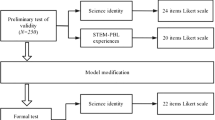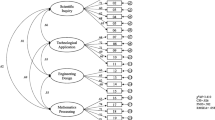Abstract
This study adopted a researcher-generated framework to analyze STEM activities demonstrated in primary students’ science projects in an annual extracurricular event held in Hong Kong. Ten students’ project reports were randomly selected from each of the three groups of 24 outstanding, 45 merit, and 68 consolation awarded projects. Content analysis was conducted to code the activities in each project. The coded information was then changed into numerical data for quantitative analysis. The results showed that, in general, more engineering and science activities than technology and mathematics activities were adopted by the primary students in their projects. More projects with the Outstanding Award conducted STEM activities than those projects with Merit and Consolation Awards, and significant group differences existed in the science and mathematics activities. Besides, science activities significantly positively related to engineering and mathematics activities. Furthermore, STEM-related content knowledge of discipline core ideas and crosscutting concepts were reported. This study sheds light on the pattern of STEM activities in students’ science projects, and has implications for promoting STEM integration in primary education.

Similar content being viewed by others
References
Ainley, J., Jarvis, T., Mckeon, F., Murphy, C., Smith, G., Varley, J., . . . Teuchert, A. (2012). Integrating science inquiry across the curriculum. Leicester, UK: Fibonacci Scientific Committee.
American Association for the Advancement of Science (AAAS). (1993). Benchmarks for science literacy. Oxford, UK: Oxford University Press.
Barab, S. A., & Luehmann, A. L. (2003). Building sustainable science curriculum: Acknowledging and accommodating local adaptation. Science Education, 87(4), 454–467.
Barrett, B. S., Moran, A. L., & Woods, J. E. (2014). Meteorology meets engineering: An interdisciplinary STEM module for middle and early secondary school students. International Journal of STEM Education, 1(1), 1–7.
Becker, K., & Park, K. (2011). Effects of integrative approaches among science, technology, engineering, and mathematics (STEM) subjects on students’ learning: A preliminary meta-analysis. Journal of STEM Education: Innovations and Research, 12(5/6), 23–37.
Breiner, J. M., Harkness, S. S., Johnson, C. C., & Koehler, C. M. (2012). What is STEM? A discussion about conceptions of STEM in education and partnerships. School Science and Mathematics, 112(1), 3–11.
Bybee, R. W. (2010). Advancing STEM education: A 2020 vision. Technology and Engineering Teacher, 70(1), 30–35.
Bybee, R. W. (2013). The case for STEM education: Challenges and opportunities. Arlington, VA: NSTA Press.
Charlesworth, R., & Lind, K. K. (2010). Math & science for young children (6th ed.). Albany, NY: Delmar.
Chin, C. (2003). Facilitating science investigations: Some suggestions for the teacher. Teaching and Learning, 24(2), 141–151.
Chiu, A. Price, C. A., & Ovrahim, E. (2015). Supporting elementary and middle school STEM education at the whole school level: A review or literature. Paper presented at NARST 2015 Annual Conference, Chicago, IL.
Curriculum Development Council (CDC). (2011). General studies for primary schools curriculum guide. Hong Kong: Education Bureau. Retrieved from http://www.edb.gov.hk/attachment/en/curriculum-development/cross-kla-studies/gs-primary/gs_p_guide-eng_300dpi-final%20version.pdf.
Dayton Regional STEM Center. (2011). STEM education quality framework. Seattle, WA: Washington STEM.
Denson, C. D., Hailey, C., Stallworth, C. A., & Householder, D. L. (2015). Benefits of informal learning environments: A focused examination of STEM-based program environments. Journal of STEM Education: Innovations and Research, 16(1), 11–15.
DePaul Science Working Group. (2013). Implementing the next generation science standards: Hallmarks of a fully realized school system. Chicago, IL: Chicago STEM Education Consortium.
Diaz, D., & King, P. (2007). Adapting a post-secondary STEM instructional model to K-5 mathematics instruction. Paper presented at American Society for Engineering Education Annual Conference and Exposition, Honolulu, Hawaii.
Fortus, D., Krajcik, J., Dershimer, R. C., Marx, R. W., & MamlokNaaman, R. (2005). Design-based science and real-world problem-solving. International Journal of Science Education, 27(7), 855–879.
Gagel, C. W. (1997). Literacy and technology: Reflections and insights for technological literacy. Journal of Industrial Teacher Education, 34(3), 6–34.
Garmire, E., & Pearson, G. (Eds.). (2006). Tech tally: Approaches to assessing technological literacy. Washington, DC: The National Academies Press.
Gott, R., Duggan, S., & Ebrary, I. (2003). Understanding and using scientific evidence. Thousand Oaks, CA: Sage.
Hayden, C. T., O’Neill, C., Meyer, J. E., Carballada, R. C., Sanford, A. L., & Cohen, S. B. (2008). Intermediate level science: Core curriculum grades 5–8. New York State Education Department. Retrieved from http://www.p12.nysed.gov/ciai/mst/pub/intersci.pdf.
Hew, K. F., & Brush, T. (2007). Integrating technology into K-12 teaching and learning: Current knowledge gaps and recommendations for future research. Educational Technology Research and Development, 55(3), 223–252.
Honey, M., Pearson, G., & Schweingruber, H. (Eds.). (2014). STEM integration in K-12 education: Status, prospects, and an agenda for research. Washington, DC: The National Academies Press.
International Technology and Engineering Educators Association (ITEEA). (2000). Standards for technological literacy: Content for the study of technology. Reston, VA: International Technology and Engineering Educators Association.
Jeong, H., Songer, N. B., & Lee, S. (2007). Evidentiary competence: Sixth graders understanding for gathering and interpreting evidence in scientific investigations. Research in Science Education, 37(1), 75–97.
Kim, M. C., Hannafin, M. J., & Bryan, L. A. (2007). Technology-enhanced inquiry tools in science education: An emerging pedagogical framework for classroom practice. Science Education, 91(6), 1010–1030.
Lee, H. S., Linn, M. C., Varma, K., & Liu, O. L. (2010). How do technology-enhanced inquiry science units impact classroom learning? Journal of Research in Science Teaching, 47(1), 71–90.
Lewis, T. (2006). Design and inquiry: Bases for an accommodation between science and technology education in the curriculum? Journal of Research in Science Teaching, 43(3), 225–281.
Lombard, M., Snyder-Duch, J., & Bracken, C. C. (2002). Content analysis in mass communication. Human Communication Research, 28(4), 587–604.
Maltese, A. V., Melki, C. S., & Wiebke, H. L. (2014). The nature of experiences responsible for the generation and maintenance of interest in STEM. Science Education, 98(6), 937–962.
Maltese, A. V., & Tai, R. H. (2010). Eyeballs in the fridge: Sources of early interest in science. International Journal of Science Education, 32(5), 669–685.
Marginson, S., Tytler, R., Freeman, B., & Roberts, K. (2013). STEM: Country comparisons: Final report. Melbourne, Australia: Australian Council of Learned Academies.
Mehalik, M. M., Doppelt, Y., & Schuun, C. D. (2008). Middle-school science through design-based learning versus scripted inquiry: Better overall science concept learning and equity gap reduction. Journal of Engineering Education, 97(1), 71–85.
National Academy of Engineering and National Research Council (NAE&NRC). (2014). STEM integration in K-12 education: Status, prospects, and an agenda for research. Washington, DC: The National Academies Press.
National Assessment of Educational Progress (NAEP). (2006). The NAEP mathematics achievement levels by grade. Center for Education Statistics: Institute of Education Sciences National. Retrieved from https://nces.ed.gov/nationsreportcard/mathematics/achieveall.asp#grade8.
National Governors Association. (2007). Innovation America: Building a science, technology, engineering and math agenda. Washington, DC: National Governors Association.
National Research Council (NRC). (2012). A framework for K-12 science education: Practices, crosscutting concepts, and core ideas. Committee on conceptual framework for the new K-12 science education standards. Board on science education, division of behavioral and social sciences and education. Washington, DC: The National Academies Press.
National Research Council (NRC). (2013). Next generation science standards: For states, by states. Washington, DC: The National Academies Press.
NGSS Lead States. (2013). Next generation science standards: For states, by states. Washington, DC: The National Academies Press.
Roehrig, G. H., Moore, T. J., Wang, H. H., & Park, M. S. (2012). Is adding the E enough? Investigating the impact of K-12 engineering standards on the implementation of STEM integration. School Science and Mathematics, 112(1), 31–44.
Sanders, M. (2009). STEM, STEM education, STEM mania. The Technology Teacher, 68(4), 20–26.
Sanders, M. E. (2012). Integrative STEM education as “best practice”. In H. Middleton (Ed.), Explorations of best practice in technology, design, & engineering education (Vol. 2, pp. 103–117). Queensland, Australia: Griffith Institute for Educational Research.
So, W. W. M. (2013). Connecting mathematics in primary science inquiry projects. International Journal of Science and Mathematics Education, 11(2), 385–406.
So, W. M. W. (2016). Representational practices in extra-curricular science inquiry projects: A study with Asian primary pupils. International Journal of Science and Mathematics Education, 14(1), 55-79.
The Pennsylvania Department of Education. (2009). Academic standards for science and technology and engineering education: Elementary standards (grades 3, 5, 6, 8). Harrisburg, PA: The Pennsylvania Department of Education.
The University of the State of New York. (2000). Intermediate level science core curriculum grades 5–8. New York, NY: New York State Education Department.
Toulmin, C. N., & Groome, M. (2007). Building a science, technology, engineering, and math agenda. Washington, DC: National Governors' Association.
Wang, H., & Nam, Y. (2015). Exploring the impact of a STEM integration teacher professional development program on secondary science and mathematics teachers’ perceptions of engineering and their attitude toward engineering integrated teaching. 한국지구과학회지 (Journal of the Korean Earth Science Society), 36(5), 484–499.
Williams, J. (2011). STEM education: Proceed with caution. Design and Technology Education: An International Journal, 16(1), 26–35.
Yore, L. D. (2011). Foundations of scientific, mathematical, and technological literacies—common themes and theoretical framework. In L. D. Yore, E. Van de Flier-Keller, D. W. Blades, T. W. Pelton, & D. B. Zandvliet (Eds.), Pacific CRYSTAL centre for science, mathematics, and technological literacy: Lessons learned (pp. 23–44). Rotterdam, The Netherlands: Sense.
Zollman, A. (2012). Learning for STEM literacy: STEM literacy for learning. School Science and Mathematics, 112(1), 12–19.
Author information
Authors and Affiliations
Corresponding author
Rights and permissions
About this article
Cite this article
So, W.W.M., Zhan, Y., Chow, S.C.F. et al. Analysis of STEM Activities in Primary Students’ Science Projects in an Informal Learning Environment. Int J of Sci and Math Educ 16, 1003–1023 (2018). https://doi.org/10.1007/s10763-017-9828-0
Received:
Accepted:
Published:
Issue Date:
DOI: https://doi.org/10.1007/s10763-017-9828-0




